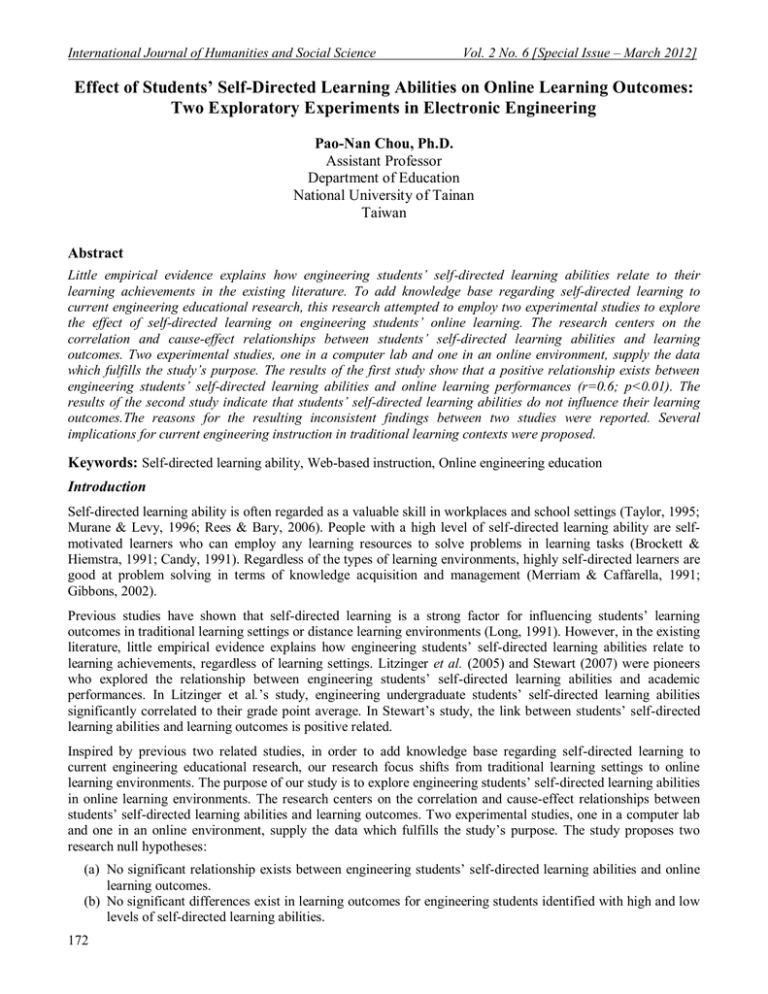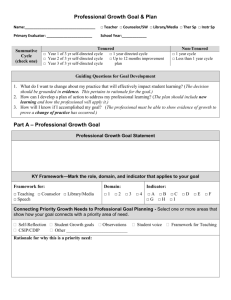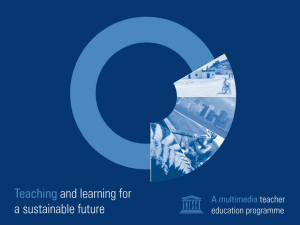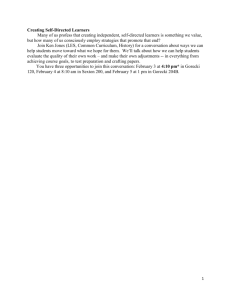Document 10467262
advertisement

International Journal of Humanities and Social Science Vol. 2 No. 6 [Special Issue – March 2012] Effect of Students’ Self-Directed Learning Abilities on Online Learning Outcomes: Two Exploratory Experiments in Electronic Engineering Pao-Nan Chou, Ph.D. Assistant Professor Department of Education National University of Tainan Taiwan Abstract Little empirical evidence explains how engineering students’ self-directed learning abilities relate to their learning achievements in the existing literature. To add knowledge base regarding self-directed learning to current engineering educational research, this research attempted to employ two experimental studies to explore the effect of self-directed learning on engineering students’ online learning. The research centers on the correlation and cause-effect relationships between students’ self-directed learning abilities and learning outcomes. Two experimental studies, one in a computer lab and one in an online environment, supply the data which fulfills the study’s purpose. The results of the first study show that a positive relationship exists between engineering students’ self-directed learning abilities and online learning performances (r=0.6; p<0.01). The results of the second study indicate that students’ self-directed learning abilities do not influence their learning outcomes.The reasons for the resulting inconsistent findings between two studies were reported. Several implications for current engineering instruction in traditional learning contexts were proposed. Keywords: Self-directed learning ability, Web-based instruction, Online engineering education Introduction Self-directed learning ability is often regarded as a valuable skill in workplaces and school settings (Taylor, 1995; Murane & Levy, 1996; Rees & Bary, 2006). People with a high level of self-directed learning ability are selfmotivated learners who can employ any learning resources to solve problems in learning tasks (Brockett & Hiemstra, 1991; Candy, 1991). Regardless of the types of learning environments, highly self-directed learners are good at problem solving in terms of knowledge acquisition and management (Merriam & Caffarella, 1991; Gibbons, 2002). Previous studies have shown that self-directed learning is a strong factor for influencing students’ learning outcomes in traditional learning settings or distance learning environments (Long, 1991). However, in the existing literature, little empirical evidence explains how engineering students’ self-directed learning abilities relate to learning achievements, regardless of learning settings. Litzinger et al. (2005) and Stewart (2007) were pioneers who explored the relationship between engineering students’ self-directed learning abilities and academic performances. In Litzinger et al.’s study, engineering undergraduate students’ self-directed learning abilities significantly correlated to their grade point average. In Stewart’s study, the link between students’ self-directed learning abilities and learning outcomes is positive related. Inspired by previous two related studies, in order to add knowledge base regarding self-directed learning to current engineering educational research, our research focus shifts from traditional learning settings to online learning environments. The purpose of our study is to explore engineering students’ self-directed learning abilities in online learning environments. The research centers on the correlation and cause-effect relationships between students’ self-directed learning abilities and learning outcomes. Two experimental studies, one in a computer lab and one in an online environment, supply the data which fulfills the study’s purpose. The study proposes two research null hypotheses: (a) No significant relationship exists between engineering students’ self-directed learning abilities and online learning outcomes. (b) No significant differences exist in learning outcomes for engineering students identified with high and low levels of self-directed learning abilities. 172 The Special Issue on Behavioral and Social Science © Centre for Promoting Ideas, USA www.ijhssnet.com Literature Review Instruments for Measuring Self-directed Learning Ability One of the instruments used for measuring self-directed learning ability, Self-Directed Learning Readiness Scale (SDLRS), was the product of Guglielmino’s doctoral dissertation (Guglielmino, 1977). The SDLRS uses a 58item 5-point Likert scale. Through factor analysis, the scale includes eight factors: openness to learning opportunities, self-concept as an effective learner, initiative and independence in learning, informed acceptance of responsibility for one’s own learning, love of learning, creativity, positive orientation to the future, and ability to use basic study and problem-solving skills. Higher scores occurring from using the scale represent higher readiness for self-directed learning. Nowadays, a number of studies have supported the reliability and validity of the scale (Hsu & Shiue, 2005). Another instrument for assessing self-directed learning ability, developed by Oddi’s doctoral dissertation, is the Oddi Continuing Learning Inventory (OCLI) (Oddi, 1984, 1986). The OCLI is a 24-item 7-point Likert scale and contains three domains established by factor analysis: proactive/reactive learning drive, cognitive openness/defensiveness, and commitment/aversion to learning. Higher scores in the scale indicate having greater characteristics of a self-directed continuing learner. In this scale, the reliability coefficient also achieves a higher level (more than 0.8). However, factor analysis conducted by a recent study suggested that Oddi’s three domains should be extended to four domains. The new four factors created are: learning with others, learner motivation/self-efficacy/autonomy, ability to be self-regulating, and reading avidity (Harvey et al., 2006). In addition to the two measurements described earlier, the Bartlett-Kotrlik Inventory of Self Learning (BKISL) has been newly developed (Bartlett & Kotrlik, 1999). This measurement is a 49-item 7-point Likert scale and contains 11 factors. According to the developers, social and environment variables, which are not included in the SDLRS or OCLI, were added to the scale. The developers also reported the measurement had high estimates for internal consistency. However, no further studies reported BKISL’s validity and reliability. Self-directed Learning Ability and Learning Performance in Online Courses By searching online education database, a review of the existing literature only identifies three case studies exploring the relationship between students’ self-directed learning abilities and learning performances in online courses. These three studies neither focused on a cause and effect relationship, nor used engineering students as targeted research subjects. No consistent findings occur in the three case studies. The three case studies are: (a) Case study 1: Pachnowski and Jurczyk (2000) employed the SDLRS to investigate the factors correlated with academic performance in a web-based learning environment. In this study, the academic performance, defined as a final course grade, consisted of students’ technical skills and attitudes according to the course instructor’s standards. The SDLRS was distributed to 17 online learners during the online course. The result of the study showed no significant relationship between students’ selfdirected learning abilities and academic performances. (b) Case study 2: Doherty (2000) attempted to find the existence of a relationship between self-directed learning and academic performance as defined by a final course grade. The study subjects were 147 college students who enrolled in online courses. The SDLRS was used to assess students’ self-directed learning abilities. The result of the study showed that students’ self-directed learning abilities did not relate to their academic performances. (c) Case study 3: In Corbeil’s (2003) study, the instrument for measuring students’ self-directed learning abilities is the OCLI. 98 graduate-level online learners participated in this semester-long study. The academic performance measure was the final grade for the course. The result of the study showed a significantly positive relationship existed between students’ self-directed learning abilities and academic performances. Since three case studies described above produced inconsistent results, applying self-directed learning to online engineering education needs several improvements in research design. First, instead of survey research, an experimental design should be employed to obtain research findings. Second, comparing the differences of available measurements assessing students’ self-directed learning abilities is necessary. Last, students’ online learning performances should be clearly defined. To add values for engineering educational research, the current study already adopts these three improvements. 173 International Journal of Humanities and Social Science Vol. 2 No. 6 [Special Issue – March 2012] Rationale for Applying Self-directed Learning to Online Engineering Education According to Bourne et al.’s (2005) study, with the availability of advanced technologies to supplement the learning needs of laboratory practice and equation manipulation in engineering education, offering online courses to continuing education of graduate engineers and degree-seeking engineering students is a growing trend at higher education institutions. Online engineering education may become a widely popular concept in the future. Therefore, a crucial need to explore how engineering students or engineers engage in online learning is necessary. In the literature, Litzinger et al. (2005) and Stewart (2007) were pioneers who applied the concept of self-directed learning to engineering educational research. However, even though a significant relationship existed between students’ self-directed learning abilities and learning outcomes in those two studies, the learning settings still occurred in the traditional classrooms. Whether or not applying self-directed learning to online engineering education may yield different findings is worthy of an extensive investigation for follow-up studies. Experimental Study 1: Lab-based Research Design The purpose of the first study is to investigate the correlative relationship between engineering students’ selfdirected learning abilities and learning outcomes (Testing of first research hypothesis). A research assumption is that students who score higher in a self-directed learning measurement might perform better in an online learning activity. The details of the research design are: (a) Subjects: Forty-eight undergraduate students majoring in electronic engineering from a technological university in Taiwan participated in the study. The participants consist of randomly selected students from eight classes in the department of electronic engineering. (b) Self-directed measurement: In this study, the SDLRS was utilized to measure students’ self-directed learning ability because the SDLRS is a widely accepted measurement to assess self-directed learning ability when compared to other two available related instruments (Merriam & Caffarella, 1991). Overall scores in the SDLRS range from 58 to 290. In this study, a reliability analysis of this measurement showed that Cronbach’s Alpha value was 0.83, which indicated the SDLRS was a reliable measurement. (c) (d) (e) (f) 174 A sample of questions in the measurement are: I can learn things on my own better than most people I can think of many different ways to learn about a new topic Learning how to learn is important to me Online learning activity: A science learning website (20 web pages), which imparts knowledge about the structure of the human body, was created. The rationale for using this instruction is that learning contents are not related to participants’ courses of study, thereby, avoiding potential threats to internal validity in the study’s experimental design (Campbell & Stanley, 1963, Gall et al., 2007). In order to confirm the validity of learning contents, the learning website underwent a review by professional instructional designers. Learning outcome: A criterion test containing 60 multiple-choice test items was used to measure students’ online learning performances. This test assesses students’ three cognitive learning outcomes: factual, conceptual, and principle/rule knowledge (Dwyer, 1978, 2007). The test’s contents substantively relate to the knowledge students received in the online learning activity. In this study, a reliability analysis showed that Cronbach’s Alpha for the test was 0.92. Research procedure: Before the study, participants responded to an SDLRS questionnaire. Subsequently, when arriving in the computer lab, students received random assignments to computer terminals from which they would complete the online learning activity. Instructions required students to read all learning contents in a one-hour session. Immediately upon completion of the instructional presentation, students received an online criterion test described earlier. Data analysis: After data collection, Pearson Product-Moment Correlation, whose purpose is to test the relationship between two independent variables (Huck, 2008), was used to analyze the relationship between self-directed learning and learning performance. The significant level was set to 0.05. The Special Issue on Behavioral and Social Science © Centre for Promoting Ideas, USA www.ijhssnet.com Findings Table 1 reports a summary of descriptive statistics regarding SDLRS scores and students’ learning outcomes. On average, students obtained 200.56 points (Standard Deviation =15.04) in the SDLRS measurement and 37.17 points (S.D. =11.27) in the criterion test. Table 1 Overall Summary for SDLRS and Criterion Test (n=48) Type of measurement SDLRS1 Criterion Test2 Minimum 165 11 Maximum 229 60 Mean 200.56 37.17 S.D. 15.04 11.27 1: Score ranges from 58 to 290 2: Score ranges from 0 to 60 Table 2 shows the result of Pearson product-moment correlation. The significant value (p=0.00 < 0.01) and correlation coefficient (r=0.6) indicates that a significant, positive relationship exists between the SDLRS and the criterion test. Since the coefficient is higher than 0.5, the correlation level tends to be medium-high according to accepted statistical standards (Huck, 2008). Table 2 Correlation Result SDLRS Coefficient P value Number Criterion Test 0.6 0.00* 48 *Significant level below 0.01 Based on the findings presented above, the first research null hypothesis was rejected. In other words, the results of the first study showed that a significant, positive relationship existed between engineering students’ self-directed learning abilities and online learning performances. Students who obtained higher scores in the SDLRS measurement performed better in the criterion test. Experimental Study 2: Online course Research Design Since the first study occurred in a laboratory setting, and a significant relationship existed between self-directed learning and learning outcome, the implementation of an experimental study, focusing on a cause and effect relationship, in a natural setting is necessary. Therefore, the purpose of the second study is to explore the effect of students’ self-directed learning abilities on learning performances in a real online course (Testing of the second research hypothesis). A research assumption is that students, identified as having a high level of self-directed learning ability, might perform better than their counterparts (i.e. learners with a low level of self-directed learning ability) on learning outcomes. The details of the research design are: (a) Subjects: Thirty-eight undergraduate students majoring in electronic engineering from a technological university in Taiwan participated in the study. These freshmen students enrolled in a course entitled, C++ Programming, in the department of electronic engineering. (b) Self-directed measurement: SDLRS measurement described in the first study assessed students’ selfdirected learning abilities of the second group. In this study, a reliability analysis of this measurement also showed that Cronbach’s Alpha value was 0.84. Students’ self-directed learning abilities assessed by SDLRS in this study represented an independent variable. (c) Online course: The course in which participants enrolled was a blended e-learning class. In other words, the course was evenly divided into two segments. The first segment was an eight-week online class in a web-based training system. The other segment was an eight-week, face-to-face class whose intent was a practical application of what students learned in the online class. This study only focused on the eightweek online class in which students received content knowledge from online interactive learning materials designed by the course instructor, and engaged in online asynchronous discussion with peers. 175 Vol. 2 No. 6 [Special Issue – March 2012] International Journal of Humanities and Social Science (d) Learning outcome: Two learning outcomes, online and academic performances, were collected for this study. First, the e-learning system created several log files to record students’ three online behaviors: the frequency of clicking the learning materials, time spent on reading the learning materials, and the number of postings on the discussion board. These online behaviors represent students’ online performances. Second, at the beginning of the face-to-face class, students completed a paper-based test, consisting of twenty problem-solving questions created by the instructor. Scores resulting from the test indicate academic performance. The rationale for the paper-based test is that students might cheat on online testing by browsing related information, which avoids potential threats to internal validity in research design. In this study, online and academic performances represent dependent variables. (e) Research procedure: At the beginning of the online class, the SDLRS questionnaires were distributed to students. After the first class, 38 copies of the questionnaires were collected immediately. During the online learning process each week, students read course materials and participated in online discussions. (f) Data analysis: After data collection, One-Way Multivariate Analysis of Variance (MANOVA), whose purpose is to test the effect of independent variables on dependent variables (Huck, 2008), was used to analyze the effect of self-directed learning on learning performance. The significant level was set to 0.05. Findings In the second study, a median score (205.5) of the SDLRS measurement segregated student participants into groups of high or low levels of self-directed learning. Table 3 reports a summary of descriptive statistics regarding high and low levels of self-directed learners on learning outcomes. Overall, the mean scores on learning outcomes between two groups are similar. Table 3 Summary of High/Low Group on Learning Outcomes (n=38) High Level Group (Mean/S.D.) Low Level Group (Mean/S.D.) Posting1 19.84/2.70 Time2 464.05/12.77 Clicking3 54.05/13.87 Paper Test4 76.32/14.08 18.21/3.30 465.16/10.86 51.53/13.06 75.58/14.54 1: The number of postings on the discussion board 2: Time spent on reading the learning materials (minutes) 3: The frequency of clicking the learning materials 4: Score ranges from 0 to 100 Detailed analytical results of MANOVA appear in Table 4. Overall, the effect of self-directed learning did not appear to influence learning performances (Posting: F=2.78; p>0.05; Time: F=0.08; p>0.05; Clicking: F=0.33; p>0.57; Paper test: F=0.025; p>0.05). Table 4 Detailed Results of MANOVA (n=38) Source A. Posting Treatments Errors Total B. Time Treatments Errors Total C. Clicking Treatments Errors Total D. Paper Test Treatments Errors Total 176 Sum of Squares DF MS F P 25.29 327.68 352.97 1 36 37 25.29 9.10 2.78 0.10 11.61 5059.47 5071.08 1 36 37 11.61 140.54 0.08 0.76 60.63 6535.68 6596.31 1 36 37 60.63 181.55 0.33 0.57 5.16 7373.74 7377.90 1 36 37 5.16 204.80 0.025 0.88 The Special Issue on Behavioral and Social Science © Centre for Promoting Ideas, USA www.ijhssnet.com In summary, the statistical results described earlier indicate that the second research hypothesis is retained because no significant difference existed for learning performances. The effect of self-directed learning did not influence learning outcomes. In other words, high level self-directed engineering learners did not perform better than their counterparts (i.e. low level self-directed learners). Learning performances for two levels of self-directed learning are the same for the online course. Discussion The current research used two experimental studies to explore the effect of self-directed learning on engineering students’ online learning. In the first study (in the lab), a positive relationship appeared between self-directed learning abilities and online learning outcomes, which provides a solid foundation to examine the effect of selfdirected learning in a real online learning environment. In the second study (in the online course), however, no significant difference appeared for the two levels (high and low) of self-directed learners on online learning outcomes. The effect of self-directed learning did not exist in the online setting. Four possible explanations for this phenomenon are: (a) Randomization: In the second study, the research design is a quasi-experimental method whose emphasis is non-randomization. Therefore, several extraneous factors, such as learners’ educational backgrounds and prior knowledge of the subject’s contents, may influence the result of the study. (b) Online learning environment: In the second study, although students engaged in online learning, their learning styles may not be suited to the Web-based learning environment. Engineering students may be demotivated by the instructional design of the online course. (c) Self-directed learning ability: In the second study, the online course lasted for eight weeks. After students were measured by the SDLRS in the beginning of the class, their self-directed learning abilities may be changed in the end of the class. Potential extraneous factors, such as instructional strategies used by the instructors, may influence engineering students’ self-directed learning abilities. (d) Online instructional activity: In the first study, students were only responsible for online reading activities. In the second study, however, students not only needed to self-manage their reading activities, but also to interact with their peers in the online discussion boards. Students’ learning burdens in the second study may surpass those in the first study, which in turn indirectly affects online learning performances. The current research cannot confirm the effect of self-directed learning on engineering students’ learning outcomes in a real-world e-learning environment. The results contradict with Corbeil’s (2003) study and support the findings in Pachnowski and Jurczyk (2000) and Doherty’s (2000) studies. However, an experimental study conducted in the lab produced a significant finding, which is consistent to Litzinger et al. (2005) and Stewart’s (2007) studies. Whether or not excluding the extraneous factors described earlier may obtain a promising result in a real-world online learning setting is worthy of further exploration. Due to the existence of a significantly positive relationship between engineering students’ self-directed learning abilities and learning performances in the first study, one follow-up pilot study, whose purpose was to test the effect of students’ curriculum majors, was conducted. The research design and process in the pilot study was the same as the first study’s. A major difference was students’ educational backgrounds. All student participants (n=34) in the pilot study majored in business administration. Through data analysis, a significant, positive relationship was also found between students’ self-directed learning abilities and learning performances (r=0.48, p<0.05). Therefore, students’ educational backgrounds may not be an extraneous factor which influences the research results. The significant findings may be generalized to other students with different educational backgrounds. Conclusion The ultimate goal of the instructional activity in the first study was to simulate an online learning task in the realworld online courses. High level of self-directed student participants tended to perform better in this instructional activity. However, a positive relationship between self-directed learning ability and learning performance cannot be applied to a real-world online learning environment. In the second study, learning performances for two levels of self-directed learners were the same in the online course. Four potential extraneous factors discussed earlier lead to the inconsistent findings: randomization, online learning environment, self-directed learning ability, and online instructional activity. 177 International Journal of Humanities and Social Science Vol. 2 No. 6 [Special Issue – March 2012] In order to confirm the role of self-directed learning ability on online learning performance, future studies need to exclude those factors before the implementation of online courses. One follow-up pilot study was conducted to test the validity of research results in the first study. A significant relationship between self-directed learning ability and learning performance for students with different educational backgrounds also existed. The consistent finding confirmed that the curriculum major might not influence the effect of self-directed learning on student’ online learning in the computer labs. However, whether or not the same results may occur in the real-world online courses still needs further clarification in future studies. Gleaning from the existence of significant findings in the first and follow-up pilot study, several implications for current engineering instruction in traditional learning contexts were proposed. First, based on the evaluation of engineering students’ self-directed learning abilities, instructors may employ different instructional strategies to support low level of self-directed learners. Two, in an effort to increase engineering students’ potential capabilities, instructors may design advanced learning materials for high level of self-directed learners. Third, in capstone design courses, instructors can assign a leader role to high level of self-directed learners whose high desires for learning new information may motivate low level of self-directed learners. Last, while creating an independent study in a class, instructors must be aware of low level of self-directed learners. Frequently adequate assistance to them is necessary. 178 The Special Issue on Behavioral and Social Science © Centre for Promoting Ideas, USA www.ijhssnet.com References Bartlett, J. E., & Kotrlik, J. W. (1999). Development of a self-directed learning instrument for use in work environments. Journal of Vocational Educational Research, 24 (4), 185-208. Bourne, J., Harris, D., & Mayadas F. (2005). Online engineering education: Learning anywhere, anytime. Journal of Engineering Education, 94 (1), 131-146. Brockett, R. G., and Hiemstra, R. (1991). Self-direction in adult learning: Perspectives on theory, research, and practice. London: Routledge. Candy, P. C. (1991). Self-direction for lifelong learning: A comprehensive guide to theory and practice. San Francisco, CA: Jossey-Bass. Campbell, D. T., & Stanley J. C. (1963). Experimental and quasi-experimental designs for research, Chicago: Rand McNally. Corbel, J. R. (2003). Online technologies self-efficacy, self-directed learning readiness, and locus of control of learners in a graduate-level web-based distance education program. unpublished doctoral dissertation. The University of Houston, Houston, TX. Doherty, P. B. (2000). Success factors among community college students in an online learning environment. Unpublished doctoral dissertation. The Nova Southeastern University, Fort Lauderdale- Davie, FL. Dwyer, F. M. (1978). Strategies for improving visual learning, State College, PA: Learning Service. Dwyer, F. M. (2007). The program of systematic evaluation (PSE): Evaluating the effects of multimedia instruction 1965-2007. Educational Technology, 47(5), 41-45. Gall, M. D., Gall, J. P., & Borg, W. R. (2007). Educational research: An introduction. 8th ed. Boston: Pearson. Gibbons, M. (2002). The self-directed learning handbook: Challenging adolescent students to excel. San Francisco, CA: Jossey-Bass. Guglielmino, L. M. (1977). Development of the self-directed learning readiness scale. Unpublished doctoral dissertation. The University of Georgia, Atherns, GA. Harvey, B. J., Rothman, A. I., & Fredker, R. C. (2006). A confirmatory factor analysis of the ODDI continuing learning inventory (OCLI). Adult Education Quarterly, 56 (3), 188-200. Hsu, Y. C., & Shiue, Y. M. (2005). The effect of self-directed learning readiness on achievement comparing face-toface and two-way distance learning instruction. International Journal of Instructional Media, 32 (2), 143-155. Huck, S. W. (2008). Reading statistics and research. 5th ed. New York: Addison Wesley Longman. Litzinger, T. A., Wise, J. C., & Lee, S. H. (2005). Self-directed learning readiness among engineering undergraduate students. Journal of Engineering Education, 94(2), 215-221. Long H. B. (1991). College students’ self-directed learning readiness and educational achievement, In H. B. Long & Associates, eds. Self-directed learning: Consensus and conflict. Oklahoma, OK: Oklahoma Research Center for Continuing Professional and Higher Education of The University of Oklahoma, 107-122. McCune, S. L., & Guglielmino L. M. (1991). The validity generalization of Guglielmino’s self-directed learning readiness scale, In H. B. Long & Associates, eds. Self-directed learning: Consensus and conflict. Oklahoma, OK: Oklahoma Research Center for Continuing Professional and Higher Education of The University of Oklahoma, 147-155. Merriam, S. B., & Caffarella, R. S. (1991). Learning in adulthood: A comprehensive guide. San Francisco, CA: JosseyBass, Pfeiffer. Murane, R. J., & Levy, F. (1996). Teaching the new basic skills. New York: Free Press. Oddi, L. F. (1984). Development of an instrument to measure self-directed continuing learning. Unpublished doctoral dissertation. The Northern Illinois University, DeKalb, IL. Oddi, L. F. (1986). Development and validation of an instrument to identify self-directed continuing learners. Adult Education Quarterly, 36, 97-107. Pachnowski, L. M., & Jurczyk, J. P. (2000). Correlating self-directed learning with distance learning success. Paper presented at The Annual Meeting of The Eastern Educational Research Association, Clearwater, FL. (ERIC Document No. ED441000) Rees, M., & Bary, R. (2006). Is self-directed learning the key skill for tomorrow’s engineers? European Journal of Engineering Education, 31(1), 73-81. Stewart, R. A. (2007). Investigating the link between self-directed learning readiness and project-based learning outcome: The case of international masters students in an engineering management course. European Journal of Engineering Education, 32 (4), 453-465. Taylor, B. (1995). Self-directed learning: Revisiting an idea most appropriate for middle school students. (ERIC Document No. ED395287) 179






